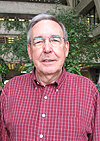Jim Hanlon retires after 28 years at Fermilab
 |
|
Jim Hanlon
|
When physicist Jim Hanlon joined Fermilab in 1985, he immediately put both his scientific expertise and leadership skills to work, heading the lab's Film Analysis Facility.
Now, after 28 years at the laboratory, Hanlon is retiring. His last day is May 29.
As group leader of the Film Analysis Facility in what was then called the Physics Department, Hanlon led the analysis of the streamer chamber film from Fermilab's E665 experiment. After completing that assignment, he took over as leader of the newly formed Physics Department Data Support Group in 1990. Then, in 1992, Hanlon began working in the Technical Support Section under Paul Mantsch on the SDC calorimeter project for the Superconducting Supercollider in Texas.
When the SSC project came to an end, Hanlon worked with Fermilab scientist Dan Green to help with the organization of a new collaboration, one that would represent the United States' contribution to the CMS experiment at a new particle collider being built in Geneva, Switzerland—the Large Hadron Collider.
Hanlon has worked on CMS ever since, serving first as U.S. CMS project administrator and then in his current position as U.S. CMS resource manager. Hanlon also served as CMS hadron calorimeter resource manager for many years.
The CMS effort continues, but it will have to continue without Hanlon, for whom "travel looms large," he said. After retiring, Hanlon will see the world, visiting China, Tibet and the Amazon rainforest. He will also spend time visiting family in Minnesota in the summers, "feeding the mosquitoes." And, of course, he'll take in some of what Chicago has to offer as well.
"I'm looking forward to day games at Wrigley Field cheering on the Cubs," he said.
A farewell gathering for Hanlon will be held on Wednesday, May 29, at 1 p.m. on the Wilson Hall 11th-floor crossover. If you'd like to attend, please RSVP to Terry Read at x6408 or Carrie Farver at x8529 by Friday, May 24.
|